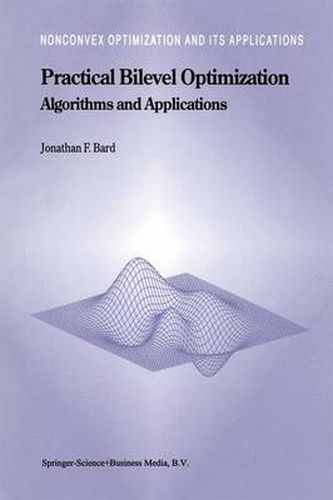Readings Newsletter
Become a Readings Member to make your shopping experience even easier.
Sign in or sign up for free!
You’re not far away from qualifying for FREE standard shipping within Australia
You’ve qualified for FREE standard shipping within Australia
The cart is loading…






This title is printed to order. This book may have been self-published. If so, we cannot guarantee the quality of the content. In the main most books will have gone through the editing process however some may not. We therefore suggest that you be aware of this before ordering this book. If in doubt check either the author or publisher’s details as we are unable to accept any returns unless they are faulty. Please contact us if you have any questions.
The focus of this book is on bilevel programming which combines elements of hierarchical optimization and game theory. The basic model addresses the problem where two decision-makers, each with their individual objectives, act and react in a noncooperative manner. The actions of one affect the choices and payoffs available to the other but neither player can completely dominate the other in the traditional sense. Over the last 20 years there has been a steady growth in research related to theory and solution methodologies for bilevel programming. This interest stems from the inherent complexity and consequent challenge of the underlying mathematics, as well as the applicability of the bilevel model to many real-world situations. The primary aim of this book is to provide a historical perspective on algorithmic development and to highlight those implementations that have proved to be the most efficient in their class. A corollary aim is to provide a sampling of applications in order to demonstrate the versatility of the basic model and the limitations of current technology. What is unique about this book is its comprehensive and integrated treatment of theory, algorithms and implementation issues. It is the first text that offers researchers and practitioners an elementary understanding of how to solve bilevel programs and a perspective on what success has been achieved in the field. Audience: Includes management scientists, operations researchers, industrial engineers, mathematicians and economists.
$9.00 standard shipping within Australia
FREE standard shipping within Australia for orders over $100.00
Express & International shipping calculated at checkout
Stock availability can be subject to change without notice. We recommend calling the shop or contacting our online team to check availability of low stock items. Please see our Shopping Online page for more details.
This title is printed to order. This book may have been self-published. If so, we cannot guarantee the quality of the content. In the main most books will have gone through the editing process however some may not. We therefore suggest that you be aware of this before ordering this book. If in doubt check either the author or publisher’s details as we are unable to accept any returns unless they are faulty. Please contact us if you have any questions.
The focus of this book is on bilevel programming which combines elements of hierarchical optimization and game theory. The basic model addresses the problem where two decision-makers, each with their individual objectives, act and react in a noncooperative manner. The actions of one affect the choices and payoffs available to the other but neither player can completely dominate the other in the traditional sense. Over the last 20 years there has been a steady growth in research related to theory and solution methodologies for bilevel programming. This interest stems from the inherent complexity and consequent challenge of the underlying mathematics, as well as the applicability of the bilevel model to many real-world situations. The primary aim of this book is to provide a historical perspective on algorithmic development and to highlight those implementations that have proved to be the most efficient in their class. A corollary aim is to provide a sampling of applications in order to demonstrate the versatility of the basic model and the limitations of current technology. What is unique about this book is its comprehensive and integrated treatment of theory, algorithms and implementation issues. It is the first text that offers researchers and practitioners an elementary understanding of how to solve bilevel programs and a perspective on what success has been achieved in the field. Audience: Includes management scientists, operations researchers, industrial engineers, mathematicians and economists.